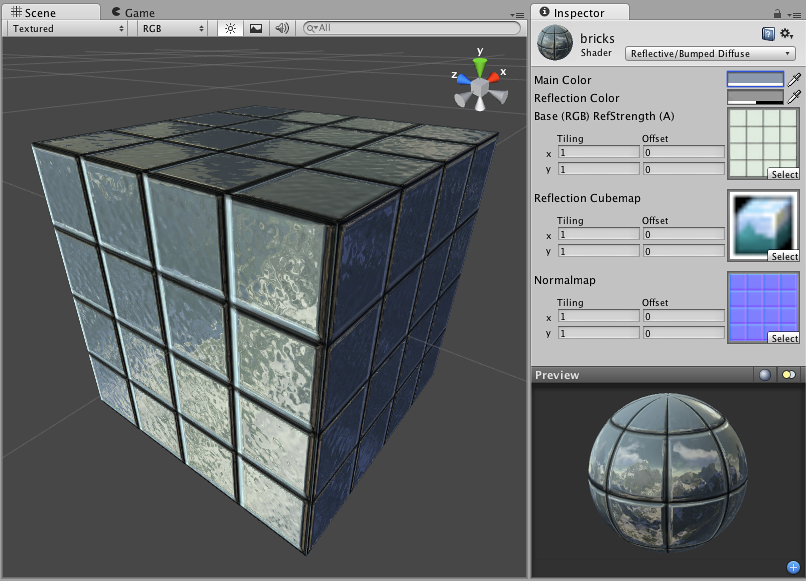Reflective Bumped Diffuse
Note. Unity 5 introduced the Standard Shader which replaces this shader.

Reflective Properties
Note. Unity 5 introduced the Standard Shader which replaces this shader.
This shader will simulate reflective surfaces such as cars, metal objects etc. It requires an environment Cubemap which will define what exactly is reflected. The main texture’s alpha channel defines the strength of reflection on the object’s surface. Any scene lights will add illumination on top of what is reflected.
Normal Mapped Properties
Like a Diffuse shader, this computes a simple (Lambertian) lighting model. The lighting on the surface decreases as the angle between it and the light decreases. The lighting depends only on the angle, and does not change as the camera moves or rotates around.
Normal mapping simulates small surface details using a texture, instead of spending more polygons to actually carve out details. It does not actually change the shape of the object, but uses a special texture called a Normal Map to achieve this effect. In the normal map, each pixel’s color value represents the angle of the surface normal. Then by using this value instead of the one from geometry, lighting is computed. The normal map effectively overrides the mesh’s geometry when calculating lighting of the object.
Creating Normal maps
You can import normal maps created outside of Unity, or you can import a regular grayscale image and convert it to a Normal Map from within Unity. (This page refers to a legacy shader which has been superseded by the Standard Shader, but you can learn more about how to use Normal Maps in the Standard Shader)
Technical Details
The Normal Map is a tangent space type of normal map. Tangent space is the space that “follows the surface” of the model geometry. In this space, Z always points away from the surface. Tangent space Normal Maps are a bit more expensive than the other “object space” type Normal Maps, but have some advantages:
- It’s possible to use them on deforming models - the bumps will remain on the deforming surface and will just work.
- It’s possible to reuse parts of the normal map on different areas of a model; or use them on different models.
Diffuse Properties
Diffuse computes a simple (Lambertian) lighting model. The lighting on the surface decreases as the angle between it and the light decreases. The lighting depends only on this angle, and does not change as the camera moves or rotates around.
Performance
Generally, this shader is cheap to render. For more details, please view the Shader Peformance page.
Did you find this page useful? Please give it a rating: